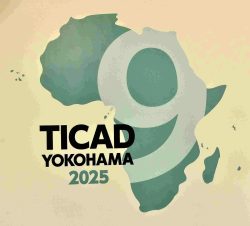13:35 JST, December 24, 2021
Almost two years have quickly passed since the novel coronavirus caught the world off guard. The world is now concerned about the spread of omicron, the latest variant. Early data from South Africa, where the variant was first found, suggest that it is likely more transmissible than delta and that the effectiveness of vaccines is waning.
But although it has been suggested that omicron is less likely than delta to cause severe illness, further verification is necessary. Coronavirus infections are known to sometimes result in long-lasting aftereffects among COVID-19 patients with mild symptoms. We need to wait and see to know exactly what post-infection symptom the omicron variant causes.
In writing the above about the omicron variant, I tried to do so as accurately as possible based on information available as of mid-December. Nonetheless, half a year from now, it may become clear that everything we know at this point is wrong. Despite worries about omicron, the variant may not spread as much as expected. Or, there may be an acute surge in seriously ill COVID-19 patients, straining medical systems around the world.
In the early days after the outbreak of COVID-19 was declared, many scientists thought it was not so important for people without coronavirus symptoms to wear masks. Not many researchers expected effective vaccines to be developed swiftly and rolled out within a year. In Japan, only a handful of researchers were able to predict that the fifth wave of the pandemic caused by the delta variant would come to a rapid end. All these developments epitomize the limitations of — and the challenges facing — science.
No crystal ball
Science is not a crystal ball that predicts the future. What science can do is help us forecast multiple possibilities regarding what may happen in the future. Scientists can establish theories but rarely reach the truth. The COVID-19 pandemic does offer an opportunity for scientists to remind themselves of their limitations and the importance of being humble.
Scientific achievements are validated through various processes. In the field of life science, when a researcher succeeds in an experiment that is the first of its kind, he or she has to first perform rounds of self-validating testing to prove the research result in question is reproducible. The second step is to send to an academic journal that publishes original scientific research papers a manuscript that must go through peer review by several experts. The third process, following the publication of the article, is to involve many fellow researchers in the world in experiments to verify the original research outcome, a step that enhances the “probability” or reliability of scientific achievements being replicated or true. The more researchers find it reproducible, the more chance it will be accepted as an established theory. But it may still be disproven later.
The novel coronavirus has brought science and society closer together than ever before. Researchers now can make public their research results with extraordinary speed. As a result, a great deal of scientific information is being conveyed to society.
However, I am afraid that scientific information is often being communicated without the clear identification of probability. One of the challenges we face amid the COVID-19 pandemic is how scientific information should be communicated to society in a way to let the specific probability levels be known as well.
I have been releasing information about the novel coronavirus since March 2020. In retrospect, there were a lot of misconceptions about the virus in the beginning.
For example, when the 2020 annual spring national high school baseball tournament was canceled, the decision was said to be aimed at protecting the safety of student players. However, given that athletic high school students are highly unlikely to develop serious symptoms after getting infected with the virus, what really mattered was to keep infections from spreading further so that older people and people with underlying health conditions would be protected from serious illness induced by the coronavirus. High school baseball players were asked to give up on their dream to play in the national tournament in order to protect society.
Some of those in leadership positions were too optimistic about the situation. While I hoped that the virus would not have a major impact on society, there already was a real possibility that the pandemic would inflict extensive damage. I am not an expert on infections or public health. Yet, as a researcher specializing in medicine and biology, I had to start conveying relevant information to society.
Importance of probability
As society is inundated with a variety of information, I strove to include sources such as journal papers and announcements by public health authorities in various countries. But, as journal papers and other reports continued to be published day after day, it was difficult to communicate such information to the general public with easy-to-understand explanations and with clues to the specific probabilities regarding each piece of information.
Britain’s public health system uses three different colors to indicate the degree of probability regarding vaccine efficacy and other related information. The importance that the governmental institution attaches to probabilities is quite fitting for Britain, with its long scientific tradition. There is a lot to learn from this country in improving the delivery of such information.
Active dissemination of information is an important process that should not be limited to the novel coronavirus. As the research activity in which I am involved is financed by tax money, we are naturally responsible for informing the taxpayers, namely the nation, of research achievements. In doing so, it is important to communicate to them by indicating the probability.
Kyoto University’s Center for iPS Cell Research and Application (CiRA), for instance, announced in October this year that a new study by its researchers showed that “the combination of two drugs halts the infection of SARS-CoV-2, the virus responsible for COVID-19, in iPS [induced pluripotent stem] cells.” In early December, the center announced the development of nanotechnology for genome editing “to correct Duchenne muscular dystrophy mutations in multiple muscle tissues.” These announcements were made when the findings of peer-reviewed research papers were released to the public.
In November, CiRA made it known that the center had embarked on a first-of-its-kind clinical trial of “in-patient transplantation of iPS cell-derived natural killer cells to treat ovarian cancer.” The launch of a clinical trial must be approved by the relevant ethics review committees, while animal testing data on safety and effectiveness must be examined by independent specialists prior to the state’s review.
We thus release information validated by independent researchers. But we still need to get our results validated by more researchers outside the center in order to have those results more widely accepted in society.
I have been invited many times to appear on television programs. Television crews responsible for those programs would energetically cover leading-edge research studies that are at different stages of progress. The first stage involves studies for which research papers have yet to be published, while the second stage refers to those in which a single research group has published. The third stage refers to studies with higher probability levels and proven reproducibility, meaning that multiple research groups have replicated the research results in question.
I usually have had rounds of careful discussion with the television crews on how to feature cutting-edge science in each program together with the specific level of probability.
In television programs focusing on cutting-edge science, of course, it is important to highlight new eye-catching research results. However, the levels of probability are not that high for many of them. There was even a case in which the research paper cited by a program had to be retracted because it was found to be based on fraudulent research.
However, if television programs mostly spotlight research achievements that have been validated by many peer researchers around the world, and therefore have high levels of probability, it will be difficult to arouse the audience’s interest, as they will likely lack novelty. Indeed, it is a difficult process to make as many people as possible interested in scientific research findings while simultaneously helping them understand the probability.
Two years have passed since the outbreak of the novel coronavirus, but we still need to stay on the alert. With the vast majority of its people vaccinated, Japan as of December was in a COVID-19 lull, having weathered the pandemic far better than other countries in the world. Nevertheless, more variants like omicron are highly likely to emerge in the future. We are not sure yet if we will remain safe after receiving only one booster vaccine shot.
The importance of science will grow in the future. I look forward to making further efforts to quickly share research results with society both by disclosing them in an easy-to-understand manner and by elaborating on the levels of probability.
"Editorial & Columns" POPULAR ARTICLE
-

Violations of Subcontract Law: Major Automakers Must Eliminate Old Practices
-

Local Governments’ Tax Revenues: Devise Ways to Correct Imbalances in Tax Sources
-

5 Japanese Business Dinner Mistakes to Avoid — and What They Taught Me About Business in Japan
-

Heavy Rains in Asia: Support for Victims, Flood-Control Measures Urgently Needed
-

New Nuclear Threat: China Seeking to Follow U.S., Russia in Military Expansion
JN ACCESS RANKING
-

Keidanren Chairman Yoshinobu Tsutsui Visits Kashiwazaki-Kariwa Nuclear Power Plant; Inspects New Emergency Safety System
-

Imports of Rare Earths from China Facing Delays, May Be Caused by Deterioration of Japan-China Relations
-

University of Tokyo Professor Discusses Japanese Economic Security in Interview Ahead of Forum
-

Japan Pulls out of Vietnam Nuclear Project, Complicating Hanoi’s Power Plans
-

Govt Aims to Expand NISA Program Lineup, Abolish Age Restriction























